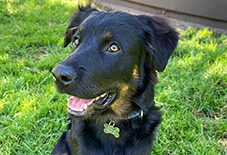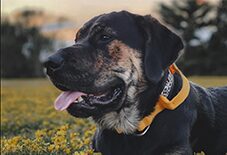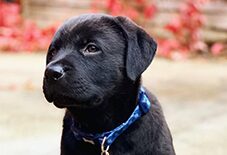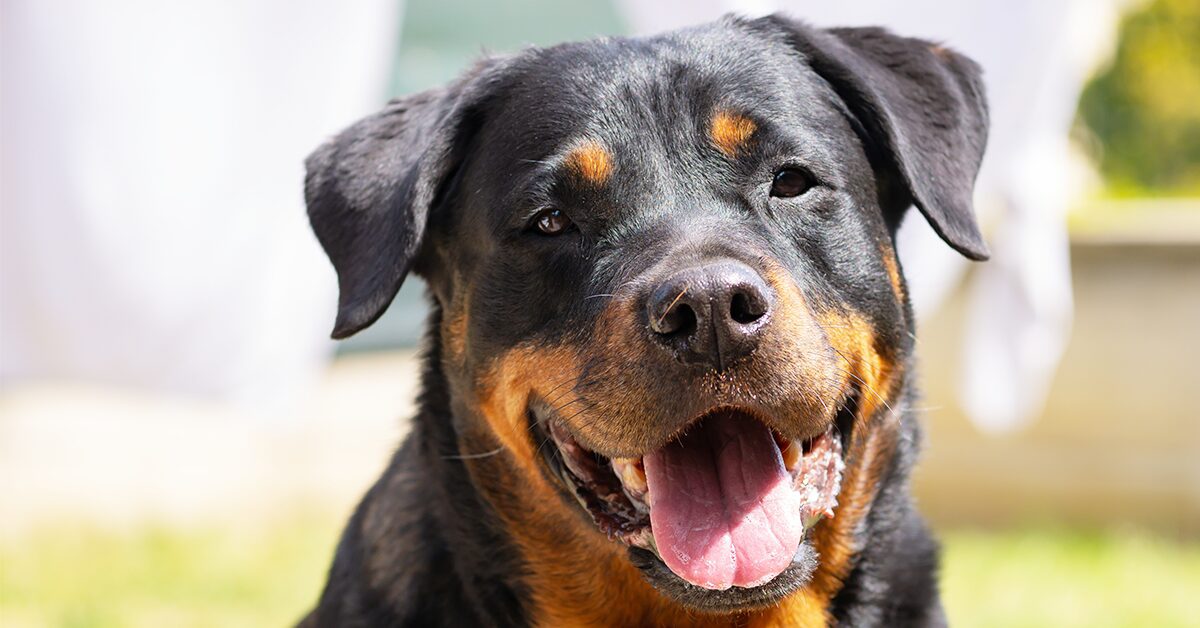
Meet the Rottweiler
Top Working Dog
Protective Pooch
Best Fur Friend
If you’re in search of a doggo who will always have your back, I could be the breed for you! Sometimes I can be protective, but don’t worry – most of us aren’t scary or aggressive. Not to brag, but we Rottweilers are a complex breed. I can be serious, and I can also be tail-waggingly goofy. I might express this by lunging my 100-something pound body up onto the couch to snuggle in your lap! Above all else, I love spending quality time with my people and making them happy as hounds. If you raise me with kids, just keep an eye on us during playtime at first. We’ll be friends, but I might bump into them from time to time because of my herding instincts. I also do well with other dogs if I’m introduced to them properly. I just don’t like strangers on my territory!
Socialization classes and obedience training as a pup help me become pawfectly behaved. I also need consistent training or I can become a little headstrong and territorial. When I’m young, you’ll find that training isn’t too difficult because I love working my tail off. Sometimes police and search-and-rescue teams enlist me to help them with their missions. What a treat! I’m really active and I love when people give me stuff to do – swimming, herding, running, I love it all! Of course, when I’m not being active, I like to kick back with my family and enjoy a good belly rub. As you can see, I like to work hard and play harder, and I’m pretty much down for anything as long as I have my loved ones by side!
Ready to learn more about me? Let’s dig in.
Ready to learn more about me? Let’s dig in.
 My Many Looks
My Many Looks
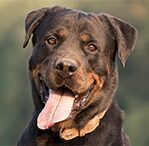
Black & Mahogany
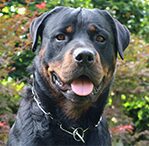
Black & Rust
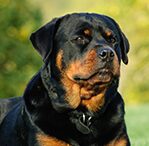
Black & Tan
 My Breed Characteristics
My Breed Characteristics
 Furbulous Fact
Furbulous Fact
We Rotties almost went extinct! During the Industrial Revolution in both Europe and the United States, our herding abilities weren’t as in demand because humans built railroads and paved roads for easier transport of cattle – which was our job! We almost vanished! Thankfully some loyal Rottie lovers worked hard to keep us around and by the 1900s, we found a new career path as protectors – joining the police force and military.
 As I Grow Up
As I Grow Up
As you can see, we Rottweilers age pretty gracefully. Here are a few key milestones in my growth and development to be aware of as I grow up from a pupper to an adult and senior!

Puppy3-4 Months
It’s impawtant to socialize me with other pups and people. Give me plenty of playtime and training by enrolling me in puppy classes.
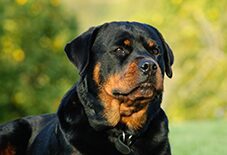
Adult1-4 Years
As intelligent and confident as I am, I’ll need consistent training to grow into a pawfectly well-behaved adult by age 2 or 3.
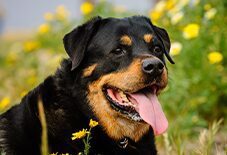
Senior8-12 years
I’m starting to slow down and may develop some joint problems. Help me feel my best by taking me for vet check-ups every 6 months.
 History of My Breed
History of My Breed
Our origins began during the expansion of the Roman Empire. Conquerors brought herds with them for easy access to food and dogs were brought along to protect the food supply. Asian mastiff type dogs, or drover dogs, were used to develop a breed of dogs that worked for the explorers, and those dogs became our distant relatives, along with a lot of other German breeds. In 1901, the earliest breed standard was drawn up, and we haven’t really changed much since.
After the Roman Empire collapsed, we found work in a cattle town called Rottweil as herding dogs. The central location of this place in Germany made it the epicenter for markets and trading – people traveled from all over to come here for supplies, which means we were petted by people from all over! Once the cattle were butchered, we were in charge of hauling carts of meat to different towns. We had coin purses attached to our necks for safekeeping – no one dared to take money from us! Humans started calling us Butcher’s Dogs of Rottweil, or more formally Rottweiler Metzgerhunds, and voila! We got our name.
Once the railroads came around and herding cattle became easier, humans didn’t have as much work for us anymore. Thankfully, our strong and protective nature allowed us to find work elsewhere as protectors! We started working as police dogs, search and rescue dogs, and service dogs – we were even some of the first dog breeds to start assisting the blind.
It’s believed that a German emigrant brought one of us along with him to America in the late 1920s and the first American Rottweiler litter was born in 1930. One year later in 1931, we were acknowledged by the American Kennel Club. We started to become more popular after WWII, but we really hit our peak in the ‘90s.
 Pawesome Pups to Parent
Pawesome Pups to Parent
In addition to purebred Rottweilers like me, there are tons of pawfectly sweet mixed-breed Rotties that are looking to find their furever homes. You can learn where to find your next pet below!
 Care Tips
from Dr. Marc Elie, Veterinarian
Care Tips
from Dr. Marc Elie, Veterinarian 
Work with a behaviorist if you notice aggression in your pup.
ehavior modification and obedience training are extra important with Rottweilers, who have a tendency to be naturally aggressive. Observe your pup’s behavior and make sure you take the appropriate steps to raise them into good dog citizens.
Watch out for signs of inflammation.
Rottweiler puppies between six and 18 months of age are particularly prone to a condition called panosteitis, which is essentially a bad case of inflammation of their bones. If your pup displays signs of lameness, fever, or pain at your touch, it may be a good idea to see your vet and start a treatment plan.
Get key health screenings your vet recommends.
Beyond your first few puppy wellness visits, get your Rottie regular screenings to catch things like hip dysplasia, arthritis, heart issues, and other conditions that may crop up as they age. You won’t always be able to catch signs and symptoms on your own, so make sure you get your pup checked out by the vet on a regular basis throughout their lifetime.
 Training Tips
from Trainers & Behavior Specialists
Training Tips
from Trainers & Behavior Specialists

Coach your Rottie pup out of their possessive tendencies.
Rotties can display possessive tendencies, unless you help coach them at an early age. Since toys are often sources of struggle, you can use them as a training tool. If a dog thinks of something as theirs, like a toy, they begin to feel ownership over it, and feel like they need to protect it. But, if you periodically take their toys away, your pup will understand that you own the toy – not them. As the toy owner, you lend it to the dog for behaving well. With enough practice, they’ll understand that the toy is a reward, not a trophy.
- Richard Lovejoy, Professional Remote Dog Trainer
Socialize your pup early in their training.
It’s important for Rottie pups to acclimate to other dogs early on, as the socialization window starts to close at 16 weeks. It’s a good idea to expose your pup to different stimuli in their environment, including other puppies and other humans. Mixing fun treats is exercise for both mind and body!
- Laura Monaco Torelli, Certified Dog Trainer
Coach your Rottie to be a great leash walker.
Rotts are a gregarious and friendly breed, but from time to time, people on the street still freeze up around them. Unless you train your dog to be a good canine citizen, they might bark as a communication strategy, which can be scary for passersby. Counter this early on by proactively coaching your Rottie to be a respectful leash walker. Take them on plenty of sniff walks, exploring environments, with lots of treats to reward their good behavior.
- Laura Monaco Torelli, Certified Dog Trainer

 Why Get Dog Insurance?
from Pumpkin®
Why Get Dog Insurance?
from Pumpkin®
While Rottweilers are a generally healthy breed, unexpected ruh-rohs can happen to any dog at any age. If your pup gets hurt or sick, pet insurance can help you say ‘yes’ to the best care, even when it’s costly. When it comes to shopping for this breed, you’ll want to choose insurance plans like Pumpkin's, which can help cover the costs associated with the hereditary conditions Rotties are prone to developing. While a reputable breeder will conduct genetic testing on your pup’s parents to help minimize the chances of passing down hereditary conditions – they can’t always be avoided. Let’s look at some common ones, and how Pumpkin Dog Insurance plans could help cover the cost of care!
 Hip Dysplasia
Hip Dysplasia
This orthopedic condition happens when the ball and socket of the hip joint doesn’t develop or work properly, leading to joint deterioration, pain, lameness, and/or arthritis. Mild cases can be managed with prescription meds and physical therapy, but severe ones may require costly surgery.
- Cost to Treat
- $1,500-$7,000 (surgical)
- Pumpkin Pays Back*
- $1,350-$6,300
 Progressive Retinal Atrophy
Progressive Retinal Atrophy
PRA affects the rods and cones of the retina and the pigmented cell layer below. PRA causes cells and the layer to deteriorate, which leads to blindness. Stem cell therapy is the only known treatment option, but keeping a dog’s environment familiar will help them get around easier.
 Hypothyroidism
Hypothyroidism
This occurs when a dog’s thyroid gland is underactive, slowing down their metabolism, and impacting major organ functions. This can be treated (but not cured) with thyroid replacement hormone therapy. Rotties have a greater risk of having a form of Hypothyroidism called Myxedema Coma.
- Cost to Treat
- $300-$5,000
- Pumpkin Pays Back*
- $270-$4,500
 Addison’s Disease
Addison’s Disease
This happens when adrenal glands stop or weaken hormone production. It occurs most commonly in young to middle-aged female dogs and causes symptoms such as vomiting, loss of appetite, and depression. Depending on the severity, intravenous therapy and Cortisol-like drugs are used for treatment.
- Cost to Treat
- $250-$500 (surgical)
- Pumpkin Pays Back*
- $225-$450
*Example illustrates reimbursement of a covered vet bill at a 90% reimbursement rate, where the annual deductible had already been satisfied and the annual limit had not yet been met. Coverage and reimbursement results vary based on policy options.

